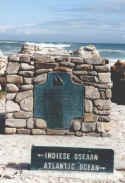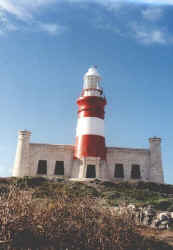SOUTHERN LIGHTS : CAPE L'AGULHAS
by Laurianne Claase, Africa EditorDeepest, darkest Africa ends not with a bang but a simper. The waves trail whimsical ribbons of lapis lazuli and aquamarine in their wake. Out there, as though it were the name of some Prohibition gin palace, sailors call it the "roaring forties." But appearances can be deceiving.
This hundred kilometre stretch of coastline is among the most hazardous in South Africa.
 It is here at the southernmost tip of the African continent that the Indian and Atlantic Oceans meet and mingle like drink-sodden guests at an aquatic cocktail party. Popular wisdom has it that the needle-sharp reefs that graze the shallows gave L'Agulhas its name. The truth is more prosaic. Early Portuguese explorers to the area found that their compass readings showed no deviation from true north and magnetic north and thus the Cape of the Needle was christened.
It is here at the southernmost tip of the African continent that the Indian and Atlantic Oceans meet and mingle like drink-sodden guests at an aquatic cocktail party. Popular wisdom has it that the needle-sharp reefs that graze the shallows gave L'Agulhas its name. The truth is more prosaic. Early Portuguese explorers to the area found that their compass readings showed no deviation from true north and magnetic north and thus the Cape of the Needle was christened.
The shipwrecks that litter the sea bed hereabouts, would seem to favour the first explanation, however. Since those Portuguese navigators of the sixteenth century, more than a hundred and thirty vessels have succumbed to this "Graveyard of Ships." Some crow-flying kilometres east up the coast, lies the wreck of the Arniston. A Dutch East Indiaman carrying wounded British soldiers, wives and children, back from the war in Ceylon, splintered on the reefs in 1815. Only six of the three hundred and seventy passengers survived. Today, the scalloped dunes and white sand beaches, coves and grottoes and turquoise bays of nearby Arniston bely the sombre history of its name.
Other ships which perished here are still remembered, if unwittingly. The Birkenhead went down further west but not before  bequeathing to posterity that stirring line: "Save the women and children first." But other wrecks have not survived the amnesia of the present. The Wooden Lady which was washed up along the Agulhas coast is a silent figurehead to the unknown ship she once adorned.
bequeathing to posterity that stirring line: "Save the women and children first." But other wrecks have not survived the amnesia of the present. The Wooden Lady which was washed up along the Agulhas coast is a silent figurehead to the unknown ship she once adorned.
It is not surprising then, that this is lighthouse territory. Unsurprising too, that the Cape of Needles should claim the second oldest lighthouse in the country. What is unexpected ,perhaps, is that it is modelled on the oldest recorded lighthouse in history; the Pharos of Alexandria -one of the seven wonders of the ancient world.
Although smaller than the hundred-and-forty metre tower of the original, the Agulhas lighthouse faithfully reproduces the limestone façade and trio of towers that distinguished its more famous predecessor. Here, far removed from their northern deserts, the winged sun and twin serpents of ancient Egypt look towards the Antarctic.
Somewhat more modest in size, this African replica is also much younger. At a hundred and fifty years old, the Agulhas beacon is a granddaddy among the lighthouses of the South African coast. In comparison, the wood-burning fires of the Pharos were maintained for fifteen hundred years before an earthquake finally destroyed the long-famous edifice in 1258.
By 1849 wood was in short supply at the southern reaches of the continent but fat-tailed sheep t here were a-plenty. Their tails provided the oil for the first light at the southernmost point of Africa. In later years, paraffin was trekked in by ox-wagon.This little historical titbit was faithfully, if rather surreally, recreated for the lighthouse birthday celebrations this year. Ox-wagons and horse-traps manned by doughty men in khaki and women in Dutch kappies filed down the road towards the lighthouse with their cargoes of Laurel paraffin. These new-age Trekkers were drawn from throughout the Overberg to take part in the three day trek along the old by-ways from Bredasdorp to Agulhas. According to the lady at the lighthouse, they take to their khakis and their carts as often as festivities allow.
here were a-plenty. Their tails provided the oil for the first light at the southernmost point of Africa. In later years, paraffin was trekked in by ox-wagon.This little historical titbit was faithfully, if rather surreally, recreated for the lighthouse birthday celebrations this year. Ox-wagons and horse-traps manned by doughty men in khaki and women in Dutch kappies filed down the road towards the lighthouse with their cargoes of Laurel paraffin. These new-age Trekkers were drawn from throughout the Overberg to take part in the three day trek along the old by-ways from Bredasdorp to Agulhas. According to the lady at the lighthouse, they take to their khakis and their carts as often as festivities allow.
The march of time and progress saw paraffin give way to electricity and by now shipwreck victims, if not saved by the light, could hope for rescue by breech buoy - an inelegant contraption which was sent out by rocket-launched line. The red and white buoy was attached to a pair of outsized canvas breeches into which survivors climbed in order to be hauled, clownishly, to safety.
By 1968 however the limestone of the lighthouse had succumbed to the elements and after a hundred and nineteen years of service, it was ignominiously replaced by a warning light on an aluminium tower. But its story was not yet done. In recognition of its illustrious past the crumbling lighthouse was declared a National Monument in 1973 and restoration work began in the following decade.
Today, the Cape Agulhas Lighthouse, restored to its former state, once again pours forth its light over the treacherous waters of two great oceans. As the local trekkers, I am sure, would tell you, the glories of the past can, sometimes, be resurrected.

